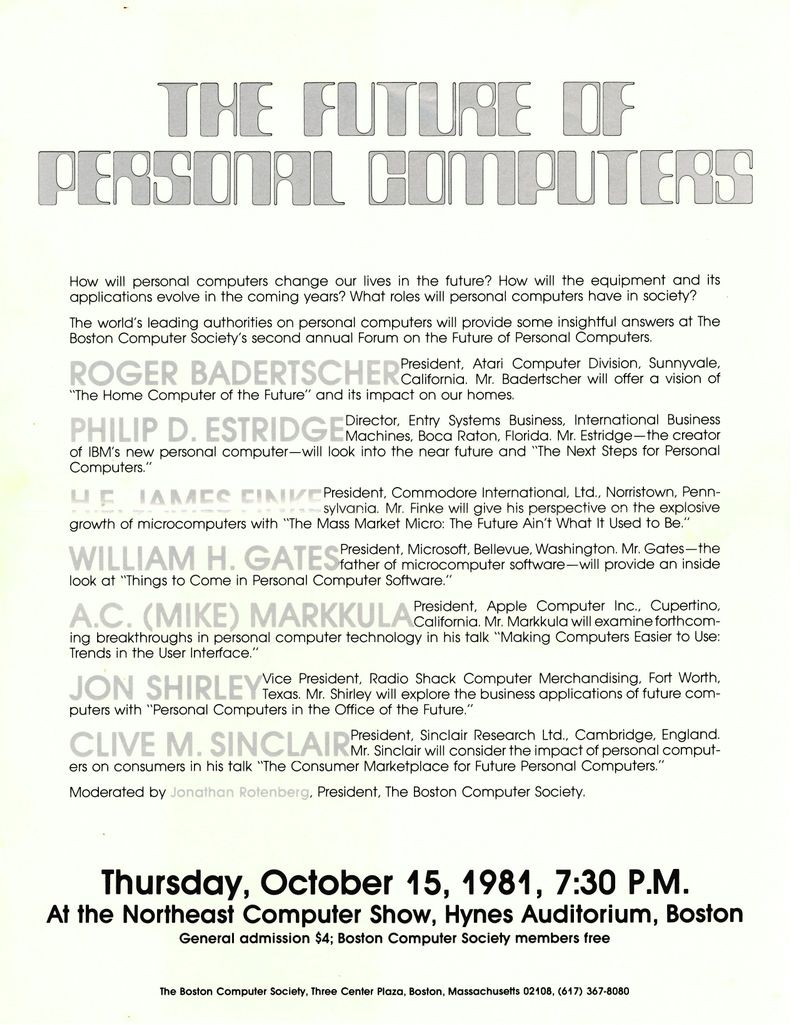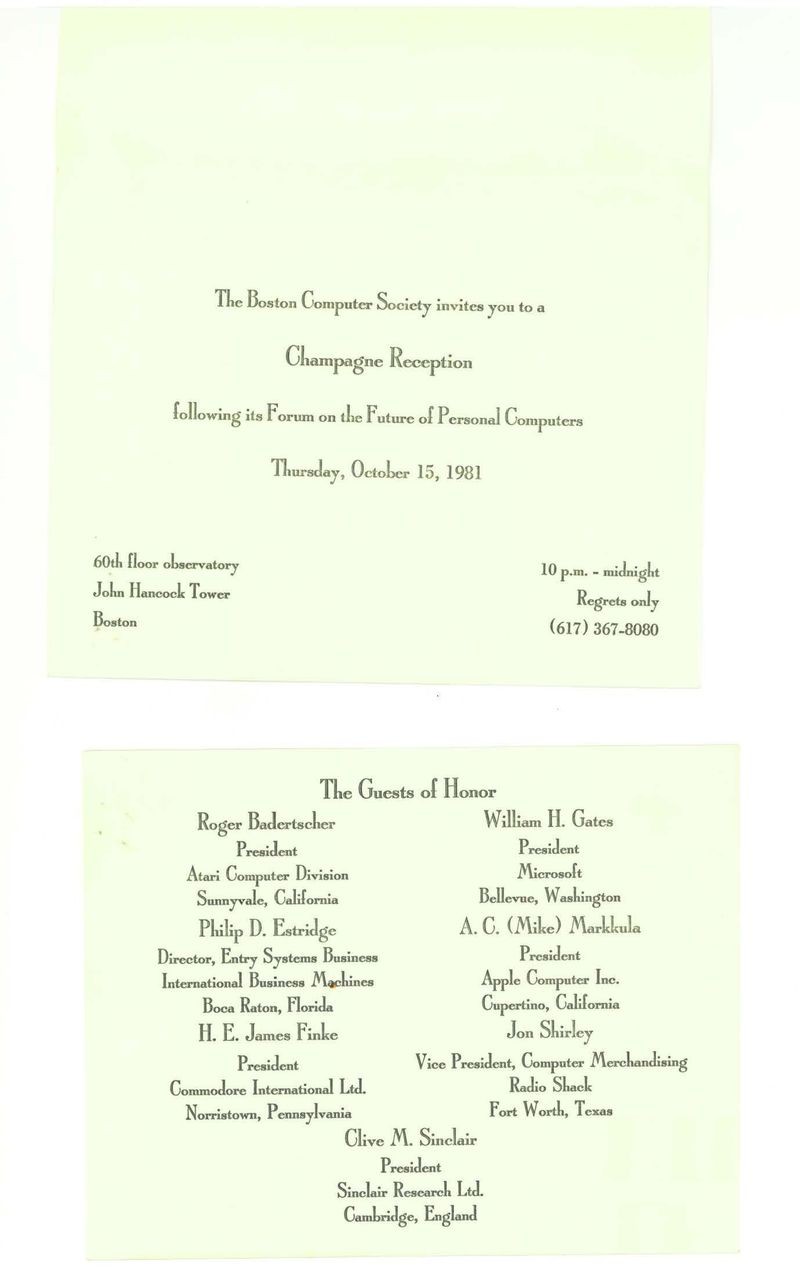
This is the first of five video releases of The Boston Computer Society (BCS) General Meetings, by the Computer History Museum (CHM). Be sure to check out CHM’s playlist of BCS videos here and learn more about BCS on @CHM.

Future of Personal Computers panel, October 15, 1981.
If you lived in the Boston area in the 1980s, you could have enjoyed an unusual front-row seat to the unfolding history of the personal computer industry. Each month, The Boston Computer Society (BCS) hosted a dialog between several hundred personal computer users and some of the most influential thought leaders of the day. Speakers at BCS monthly meetings included path makers from Steve Jobs to Michael Dell, Bill Gates to Mitch Kapor, Douglas Engelbart to Seymour Papert, Esther Dyson to Stewart Alsop, Nolan Bushnell to Ray Kurzweil.
Personal computer companies often brought their most groundbreaking new products to Boston for BCS members to review and critique. A successful BCS introduction could be an early indicator of success in the marketplace. Products that were not well received at the BCS were often doomed in the market. Major breakthroughs that had their first public showings at the BCS included: VisiCalc, Lotus 1-2-3, Compaq Portable, and Apple Macintosh.
Now, over the course of 2015 and 2016, these remarkable events are being brought back to life for the first time. Thanks to the generous support of the Computer History Museum, the general public will soon be able to experience videos of some of the major BCS General Meetings of the 1980s. Videos from the BCS general meetings will be released in a series of five batches to this playlist on the Museum’s YouTube channel. Viewers will be able to relive the unfolding history and witness the debates and dialog about an exciting new industry with seemingly limitless possibilities. Viewers will experience major pivot points in personal computing history, just as BCS members did each month.
The first BCS video in this series features a forum the BCS ran in October 1981 on “The Future of Personal Computers.”

Flyer from the BCS “Future of Personal Computers” forum, October 15, 1981.
This forum was unlike anything the BCS—or any personal computer user group—had ever attempted. It brought together the CEOs of the six largest personal computer companies of 1981 and the largest software company of the day. Seated together on a panel, I asked each to share his thinking on the future of personal computers.
Despite its great promise in 1981, the personal computer was still the domain of bold, early adopters. Software applications were not easy to use; you had to study lengthy manuals and learn whole new languages of codes and commands to operate a program. Much of the world was not at all comfortable interacting with a computer. (ATMs were still new and people went to secretarial school to learn how to type.) And a personal computer was nowhere near as reliable as an office machine like the IBM Selectric typewriter. Memory chips could fail, disks could be scratched, and machines could be unable to boot up.
Yet everything was about to change.
Several weeks before the BCS forum, the most powerful computer company in the world had announced its entry into the nascent industry: IBM. IBM was the gold standard of business computing. Suddenly its IBM PC seemed to make personal computers a legitimate purchase for businesses.

BCS reception invitation, honoring panelists from the 1981 forum.
On the other side of the consumer spectrum, the most powerful home entertainment company, Atari, had introduced its entry into the arena: the Atari 800.
Both the IBM and Atari machines were viewed as “next-generation” computers. They were created by large companies that had studied the moves of the early pioneers and set out to create what they saw as the first truly mass-market products. Atari and IBM both acknowledged that the Apple II was the inspiration for their products. The IBM PC, however, would be “industrial strength,” ready for big business. The machine was built like a tank with industry-standard components and a massive IBM service organization behind it. The Atari 800 would be truly consumer-friendly. Unlike the Apple II, there were no circuit boards visible to the user in an Atari 800. Instead of the Apple’s plug-in circuit cards for adding memory, floppy disk controllers, or other peripherals, the Atari had friendly-looking plug-in cartridges.
Across the Atlantic, a famous British entrepreneur named Clive Sinclair had an entirely different idea of how personal computers could go mainstream. The problem, as he saw it, was that the typical $2,000–$3,000 personal computer was way too expensive for most consumers. (Keep in mind that $2,000–$3,000 in 1981 would be $6,000–$9,000 in 2015.) Sinclair created the world’s most affordable—and quite beautiful—personal computer, the ZX-80, for only $150. The ZX-80 was built on the cutting-edge industrial design and innovative software engineering that had made Sinclair’s gorgeous, affordable calculators so successful.

With IBM launching a massive new entry from the world of big business, Atari coming from the world of big entertainment, and Sinclair revolutionizing low-cost consumer electronics, where would that leave the incumbents? The three leading personal computers of the day, the Radio Shack TRS-80, Commodore PET, and Apple II, were determined to stay relevant.
All of these dynamics played out at the BCS forum. And there was yet another wild card still: A young man named Bill Gates and a software company called Microsoft. Microsoft was known as the company that made programming languages and system tools (like BASIC and Xenix). Bill had recently inked a deal to produce the disk operating system for the IBM PC, MS-DOS.
This was unfolding in real time as the BCS convened the seven most influential CEOs of the day:
As you watch the video, here are a few interesting things to note:
It was an amazing evening—and quite a thrill to have been there!
The Computer History Museum is releasing 21 historic, newly digitized films from its media archive featuring General Meetings of the Boston Computer Society (BCS). The videos will be released in batches as part of a unique playlist on the Museum’s YouTube channel, beginning in fall 2015.
BCS, active in the 1980s and 1990s, was the world largest personal computer user organization, with more than 32,000 members in all 50 United States and 40 countries. General Meetings took place monthly and featured an industry luminary unveiling a major new product or new research. Unlike industry conferences, BCS provided a forum for direct dialog between industry leaders and end-users. The meetings were followed closely by the national news media; the media came to see the meetings as a key early barometer of end-user response to new products and ideas. Their importance helped draw the top speakers. BCS was founded by Jonathan Rotenberg.